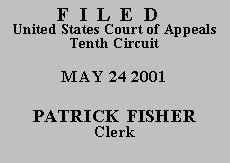

| UNITED STATES OF AMERICA, | No. 00-3252
(D.C. No. 99-CR-40063-DES) (D. Kan.) |
Because he did not raise his argument below, Housel has waived review of all but plain error. United States v. Dwyer, 245 F.3d 1168, 1170 (10th Cir. 2001). To reverse, we must find (1) error that is (2) plain, (3) affects the defendant's substantial rights, and (4) "seriously affects the fairness, integrity or public reputation of judicial proceedings." Johnson v. United States, 520 U.S. 461, 467 (1997) (alteration omitted). Factual disputes not raised below do not amount to plain error. United States v. Svacina, 137 F.3d 1179, 1187 (10th Cir. 1998). We therefore accept the factual findings of the PSR and review only whether the PSR's application of the guidelines to these facts was plain error.
The PSR determined that Housel's related conduct included attempting to manufacture methamphetamine. (PSR ¶¶ 21-22, 106.) An informant had reported that Housel was setting up a methamphetamine lab and needed to locate red phosphorus, iodine crystals, and ephedrine tablets. (PSR ¶ 6.) Housel told an undercover officer that he had the needed cookware and was merely waiting for the precursor chemicals. (PSR ¶ 8.) After some negotiations, Housel purchased phosphorus, iodine, and pseudoephedrine from the officer. (PSR ¶¶ 8, 12, 14.) Laboratory analysis indicated that from the quantity of phosphorus, Housel could have produced 1043 grams of methamphetamine.(1) (PSR ¶ 14.) Using the table in § 2D1.1 of the Sentencing Guidelines, the PSR converted the methamphetamine to 10,430 kilograms of marijuana and added it to the 1.13 kilograms of marijuana the transactions underlying the charged offenses. (PSR ¶ 23.)
Housel argues that this related conduct should have been treated as possession of a listed chemical, for which sentences are ordinarily calculated under § 2D1.11. Pseudoephedrine and iodine are both listed chemicals. See 21 U.S.C. § 802(34), (35). The PSR, however, treated Housel's conduct as amounting to an attempt to manufacture methamphetamine, a controlled substance, and the sentence for this offense is governed by § 2D1.1.(2) We decline to disturb the PSR's factual determination or to hold that application of § 2D1.1 was plain error in this case.
The cases that Housel relies on most heavily are readily distinguishable because they did not involve attempts to manufacture methamphetamine. In United States v. Hoster, 988 F.2d 1374, 1382 (5th Cir. 1993), the court found that it was plain error to aggregate the quantities of a controlled substance (amphetamine) and a listed chemical (phenylacetic acid) by treating phenylacetic acid as equivalent to phenylacetone, which is listed in the conversion tables under § 2D1.1. The court noted that "there is nothing in the Guidelines by which one could infer a relationship between phenylacetic acid and phenylacetone." Id. at 1382 n.21. Similarly, in United States v. Wagner, 994 F.2d 1467, 1472 (10th Cir. 1993), we found that it was plain error to convert P2P a controlled substance that is a precursor chemical to methamphetamine into methamphetamine and then convert that into marijuana to aggregate quantities under § 2D1.1. We held instead that the P2P should have been converted directly to marijuana in accordance with the Guidelines' table. Id. In this case, however, Housel's offense was attempting to manufacture methamphetamine, so the quantity of methamphetamine that he was capable of making was relevant. See United States v. Griggs, 71 F.3d 276, 280 (8th Cir. 1995).
Housel's brief seems to suggest that his counsel below erred in failing to preserve proper objections to the PSR. (Opening Br. at 5.) He has not directly raised a claim of ineffective assistance of counsel, and we rarely consider the issue on direct appeal. See United States v. Galloway, 56 F.3d 1239, 1240-41 (10th Cir. 1995) (en banc). If Housel wishes to pursue this argument, he must do so in a collateral proceeding under 28 U.S.C. § 2255.
We AFFIRM Housel's sentence.
ENTERED FOR THE COURT
David M. Ebel
Circuit Judge
*.After examining appellant's brief and the appellate record, this panel has determined unanimously that oral argument would not materially assist the determination of this appeal. See Fed. R. App. P. 34(a)(2) and 10th Cir. R. 34.1(G). The case is therefore ordered submitted without oral argument. This Order and Judgment is not binding precedent, except under the doctrines of law of the case, res judicata, and collateral estoppel. The court generally disfavors the citation of orders and judgments; nevertheless, an order and judgment may be cited under the terms and conditions of 10th Cir. R. 36.3.
1.Housel does not appear to challenge this calculation.
2.Even when the underlying offense is possession of a listed chemical, the Sentencing Guidelines state that § 2D1.1 should be applied if the defendant's actions constitute an attempt to manufacture a controlled substance and if that section results in a higher offense level. § 2D1.11(c) & Application Note 2.